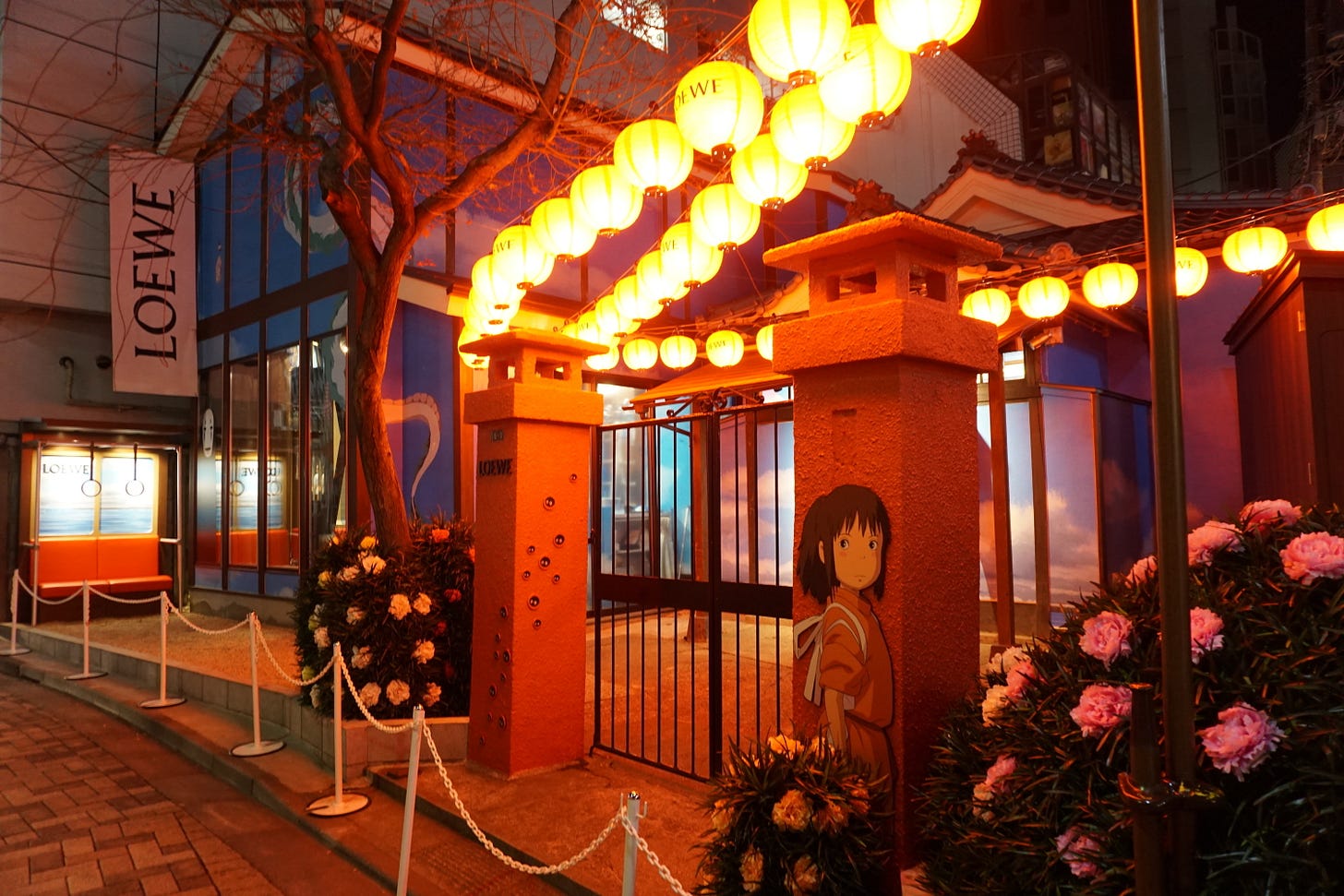Customers are tired of shopping, they want to dream!
Loewe's x Ghibli turning Shopping into Storytelling
When I first stepped into Loewe's Howl's Moving Castle pop-up in Omotesando last year, I half expected to see Calcifer grumbling about bacon in the corner. Instead, I found myself in a masterclass of experiential retail.
Surrounded by meticulously crafted details from Hayao Miyazaki's beloved film, I couldn't help but think: "Well played, Loewe. Well played."
While most luxury brands still adhere to the "put it on a pedestal and hope for the best" school of retail, Loewe has been busy elevating shopping into an art form. And we're talking full-blown, Studio Ghibli-level artistry here.
Let's rewind a bit. In 2022, Loewe kicked off its Ghibli collaboration with a Spirited Away campaign in Harajuku that had us all ready to risk it all for a magical bathhouse experience (minus the whole turning-into-a-pig part, of course). Fast forward to 2023, and they've upped the ante with Howl's Moving Castle.
At this rate, I'm half expecting a Totoro-themed forest to sprout up in the middle of Paris Fashion Week next year. (Loewe, if you're reading this, that's a free idea. You're welcome.)
These aren't mere pretty pop-ups. Loewe has tapped into something much deeper. They've realized that in today's market, selling a handbag falls short. You need to sell a story, an experience, a whole darn fantasy world.
And boy, did they deliver…
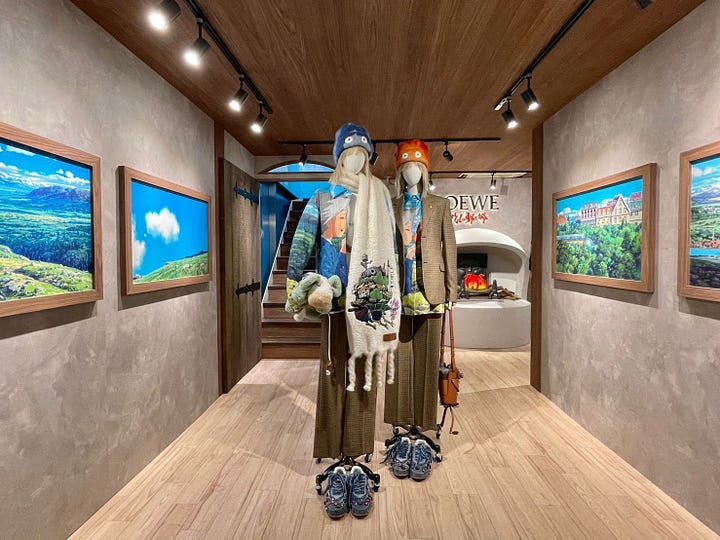
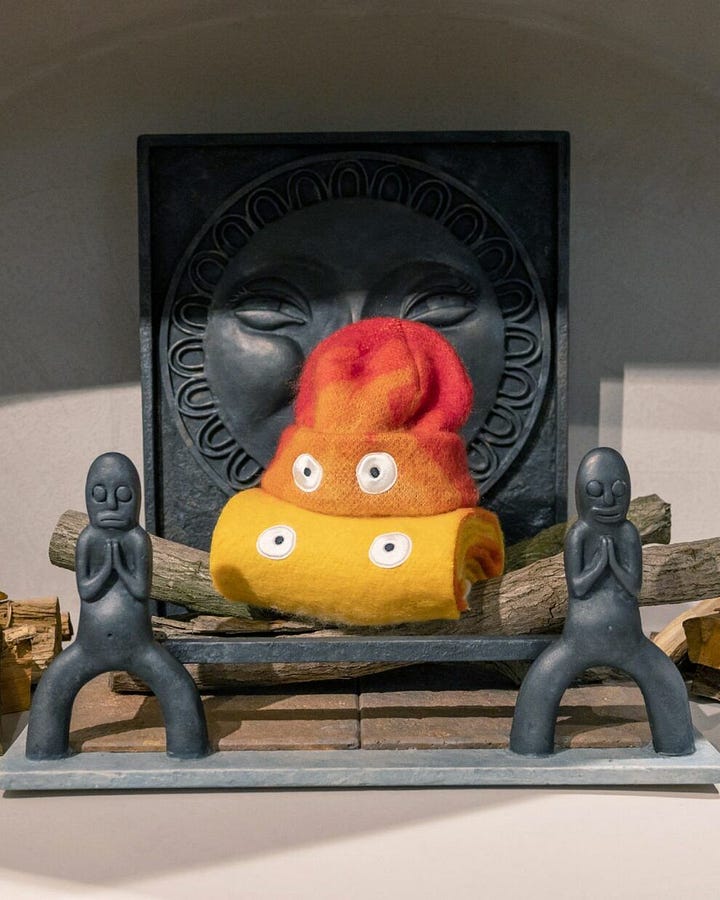
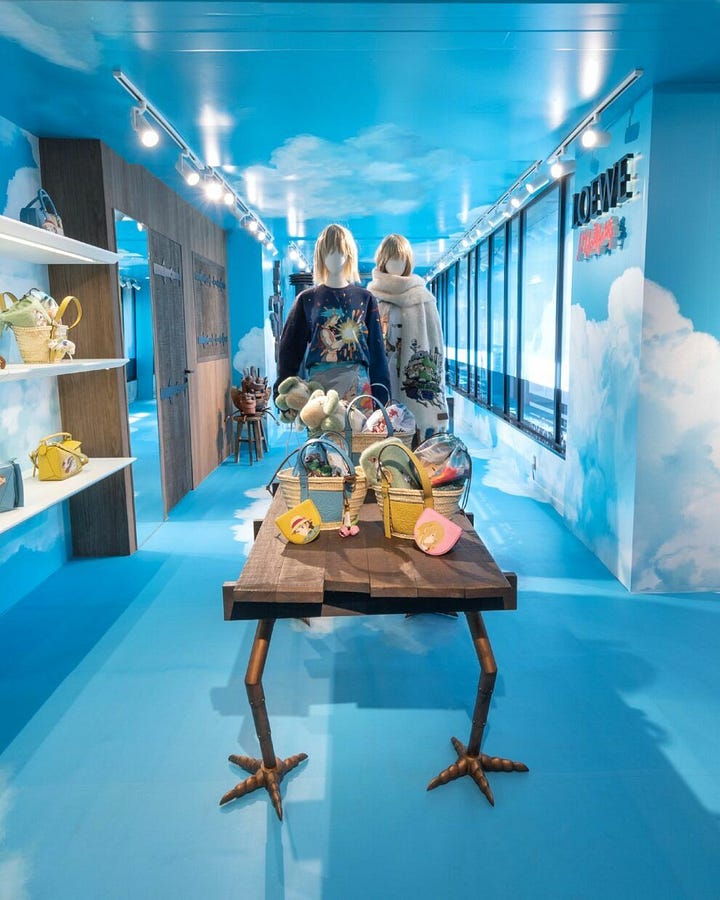
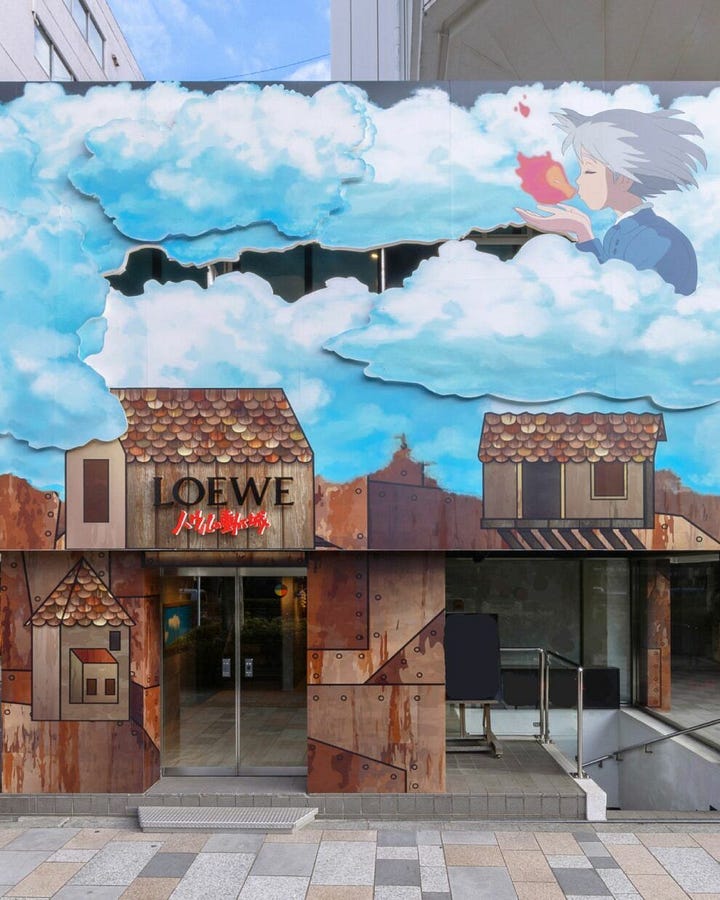
But what exactly makes these experiences so effective? It's not just about the stunning visuals or the nostalgia factor. There's some serious science at play here. Let's break it down:
1. Memory Anchoring: The Power of Contextual Association
By recreating iconic scenes from beloved films, Loewe taps into the hippocampus, the brain's center for memory formation. This creates powerful contextual associations between their products and cherished memories. That Puzzle bag isn't just an accessory; it's now linked to the warmth and magic of Calcifer in Howl's Moving Castle.
Neuroscience tells us that emotional experiences are more likely to be remembered than neutral ones. By associating their products with beloved characters and scenes, Loewe is essentially piggy-backing on the positive emotions already linked to these films. This association strengthens brand recall and emotional connection, potentially influencing future purchasing decisions.
It's a clever way of ensuring that when you think of that heartwarming scene from Howl's Moving Castle, you're also thinking of Loewe.
2. The Heroic Self: Narrative Transportation Theory in Action
We're hardwired to engage with stories, especially ones where we can envision ourselves as the protagonist. Loewe leverages this through narrative transportation theory. By stepping into these curated environments, customers don't just observe—they become active participants.
Research in narrative transportation shows that when people are immersed in a story world, it can influence their real-world beliefs and attitudes. Loewe is essentially creating a narrative that customers can step into, making the brand a part of their personal story. This self-insertion activates the medial prefrontal cortex, associated with self-reflection and personal relevance.
The result? A deeper, more personal connection to the brand and its products. Suddenly, buying that Loewe jacket isn't just a purchase—it's part of your character development.
3. Liminal Spaces: The Psychology of Transitional Environments
Loewe's use of liminal spaces—those ambiguous "in-between" areas—is a stroke of genius. These transitional environments trigger a state psychologists call "the liminal mind," where our usual mental constructs are suspended.
Liminal spaces create a sense of possibility and transformation. In retail, this can make customers more open to new experiences and ideas—including, of course, new products. This cognitive flexibility makes us more open to new ideas and experiences. In retail terms, it creates a unique psychological state where customers are more receptive to brand messaging and more likely to form lasting impressions.
By blurring the lines between reality and fantasy, Loewe creates a shopping experience that feels like stepping through the wardrobe into Narnia (yes different franchise)—a place where anything is possible, including spending a month's rent on a handbag.
4. Symbolic Thinking: Elevating Products to Mythic Status
In these Ghibli-inspired spaces, Loewe taps into our capacity for symbolic thinking—a cornerstone of human cognition. By imbuing their products with narrative significance, they elevate them from mere objects to symbols laden with meaning.
This process engages the anterior temporal lobe, involved in semantic memory and conceptual knowledge. A scarf becomes more than an accessory; it's a potential magical artifact. This symbolic elevation can significantly enhance perceived value and emotional attachment to the products.
Symbols are powerful because they compress meaning. When a brand successfully associates itself with a powerful symbol, it's not just selling a product, but a condensed set of meanings and values. This process engages the anterior temporal lobe, involved in semantic memory and conceptual knowledge. A scarf becomes more than an accessory; it's a potential magical artifact. This symbolic elevation can significantly enhance perceived value and emotional attachment to the products.
Now, I can already hear some of you saying, "But isn't this all a bit... much? It's just shopping, after all." To which I say: in a world where we can order anything with a click and have it delivered faster than you can say "free returns," the in-person retail experience must offer something more. And that's exactly what Loewe is doing.
They're selling dreams, memories, and experiences. They're tapping into our nostalgia, our desire for magic in the mundane, and our secret wish that maybe, just maybe, we'll turn a corner and find ourselves in a world where dust bunnies come to life and radish spirits commute on trains.
The genius of Loewe's approach lies in its understanding that luxury today transcends the product – it's about how that product makes you feel. By aligning themselves with the emotional resonance of Studio Ghibli's films, they've created a brand experience that sticks with you long after you've left the store.
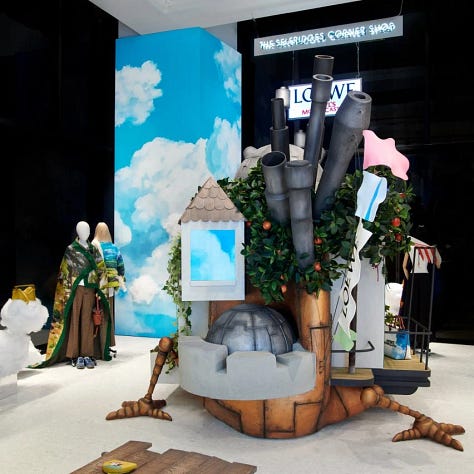


So, what can other brands learn from Loewe's Ghibli gambit?
A few key takeaways:
Strategic Partnerships are Crucial The Ghibli partnership works because there's a natural alignment between the whimsical, craftsman-like quality of Miyazaki's films and Loewe's brand ethos. When considering collaborations, brands should look beyond mere popularity and seek partners that share their values and aesthetic sensibilities.
Create Immersive Worlds, Not Just Stores The more immersive the experience, the more memorable (and Instagram-worthy) it becomes. This doesn't necessarily mean recreating entire movie sets. Even small touches that engage multiple senses can make a big difference in creating a cohesive brand world.
Leverage Emotional Connections Whether it's nostalgia, wonder, or the simple joy of experiencing something new, emotional connections drive brand loyalty far more than any logo ever could. Brands should consider how they can tap into universal emotional experiences that resonate with their target audience.
Attention to Detail Matters It's the little details – like the Calcifer-inspired display in the Howl's Moving Castle pop-up – that transform a nice store into an unforgettable experience. These small touches show a deep respect for both the source material and the customer, enhancing the overall perception of quality and care.
Understand the Science Behind the Magic While these experiences feel magical, they're grounded in solid psychological principles. Brands that understand and leverage these principles can create more effective, resonant experiences.
Particularly in the luxury sector, I believe we'll see more brands following Loewe's lead. The line between retail and entertainment will continue to blur, and shops will become stages for brand storytelling.
Loewe reminds us of the power of actual, tangible magic in a world when digital experiences progressively rule our life. They have created environments where fantasy and reality merge, where a luxury purchase fits within a larger adventure.
I started to see the world a little differently as I was leaving the Howl's Moving Castle pop-up. Every street corner seemed to be magical, every shopfront a possible portal to another world. And isn't that what excellent retail should aim for ultimately? Even momentarily, it should affect our perspective of the world.
For experiential retail, Loewe has raised a new benchmark. One thing is certain: the future of luxury retail is not only about what you're selling, but also about the world you're inviting your consumers to participate in. Other brands rush to catch up. For Loewe, it's a magical, whimsical world with exquisitely made pursues.
And who wouldn't wish to join that?
If you made it to the end ~ Kudos and thank you. If you liked this article please consider subscribing so you can see new content as soon as it’s ready!





